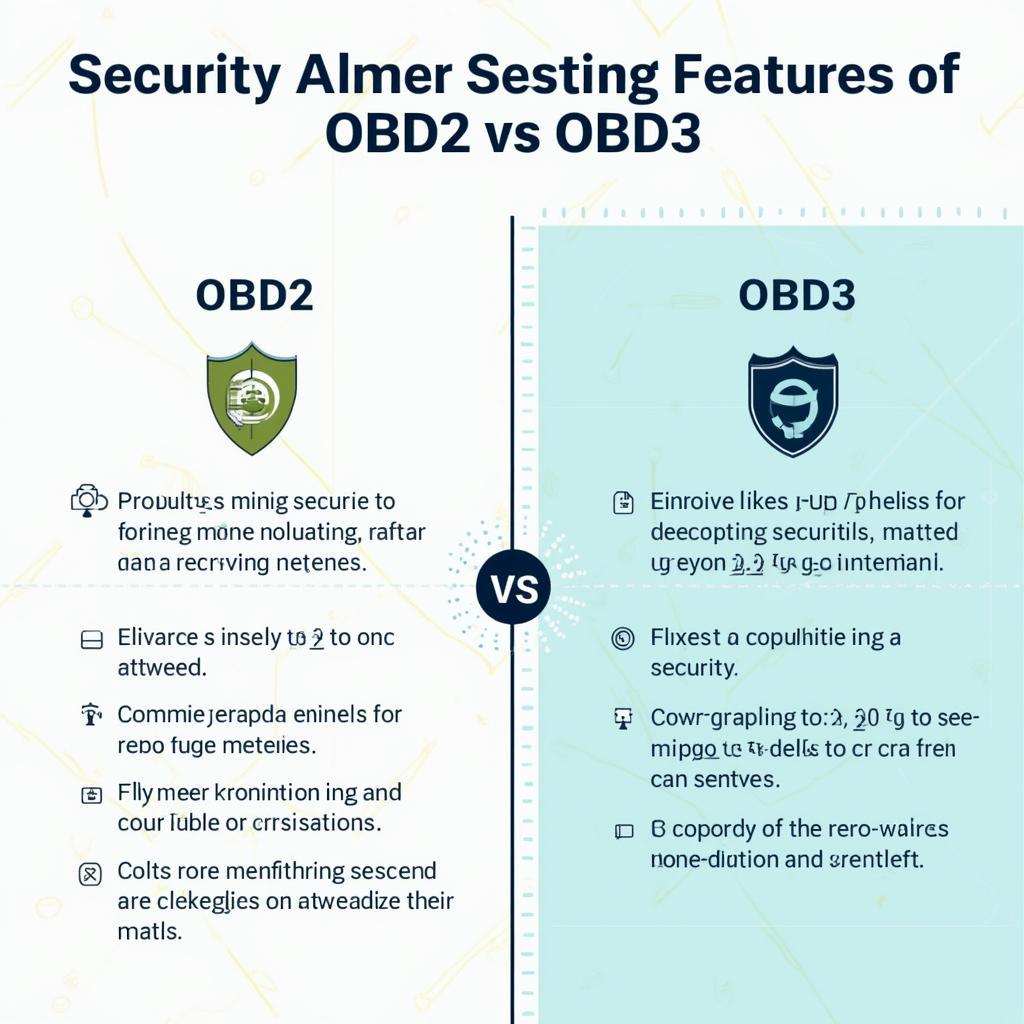OBD2 vs. OBD3 is a common query among car enthusiasts and mechanics. While OBD2 (On-Board Diagnostics, Second Generation) is the current standard, OBD3 represents the future of vehicle diagnostics. This article delves into the key distinctions between these two systems, exploring their functionalities, benefits, and the potential implications of the upcoming OBD3 standard.
Understanding the differences between OBD2 and the anticipated OBD3 is crucial for anyone involved in vehicle maintenance and repair. OBD2 has been the reigning standard for over two decades, enabling mechanics and car owners to diagnose vehicle issues effectively. But what does the shift towards OBD3 entail? Will it revolutionize vehicle diagnostics? Let’s explore.
This article will provide a comprehensive comparison of OBD2 and OBD3, covering everything from their core functionalities to their security features. We’ll also discuss the potential timeline for OBD3 implementation and what it means for the automotive industry. For example, the foxwell fw601 elm327 obd2 scanner is a popular tool for interfacing with OBD2 systems.
What is OBD2?
OBD2, introduced in the mid-1990s, is a standardized system that allows external devices to access a vehicle’s diagnostic data. This data provides insights into the performance of various vehicle systems, including the engine, transmission, and emissions control. OBD2 scanners enable mechanics to quickly identify and troubleshoot problems, saving time and reducing repair costs.
OBD2 utilizes a standardized connector, located under the dashboard, and a set of communication protocols. This standardization ensures compatibility across different vehicle makes and models, making it a versatile and essential tool for the automotive industry.
What is OBD3?
OBD3 is still largely in its conceptual phase, representing the envisioned next generation of on-board diagnostics. While no official specifications have been finalized, it’s expected to leverage advancements in telematics and wireless communication to provide real-time diagnostic data transmission. This means continuous monitoring and reporting of vehicle performance, emissions, and even potential safety issues.
One of the key anticipated benefits of OBD3 is enhanced security features. This aims to address vulnerabilities in the current OBD2 system, which can be susceptible to hacking and unauthorized access.
 OBD2 vs. OBD3 Security Comparison
OBD2 vs. OBD3 Security Comparison
Key Differences: OBD2 vs. OBD3
Security Enhancements
A primary differentiator between OBD2 and OBD3 will be the focus on security. OBD3 is expected to incorporate robust encryption and authentication mechanisms to prevent unauthorized access and manipulation of vehicle data. This is a significant improvement over OBD2, which has known security vulnerabilities.
Real-time Monitoring and Reporting
OBD3 envisions a shift towards continuous monitoring and reporting of vehicle data. This allows for proactive identification of potential problems, potentially preventing breakdowns and reducing maintenance costs. This real-time data transmission will also facilitate more efficient emissions monitoring and compliance verification.
Wireless Communication
OBD3 is anticipated to embrace wireless communication technologies, eliminating the need for physical connection to the OBD port. This facilitates remote diagnostics and data access, providing greater flexibility and convenience for both mechanics and car owners. Understanding these core differences helps clarify the evolving landscape of vehicle diagnostics. Just like comparing the ka23de obd vs obd2 ecu, the nuances between OBD2 and OBD3 become clearer.
Will OBD3 Replace OBD2 Completely?
While OBD3 represents the future, it’s unlikely to completely replace OBD2 immediately. The transition will be gradual, with both systems coexisting for a period. Manufacturers will likely implement OBD3 features incrementally, adapting to evolving regulations and technological advancements.
“The automotive industry is constantly evolving,” says automotive expert Dr. Alan Smith, “and OBD3 is a natural progression in vehicle diagnostics. It will enhance security, improve efficiency, and provide more valuable data for both consumers and manufacturers.”
When Will OBD3 Be Implemented?
There’s no definitive timeline for the widespread implementation of OBD3. The development and adoption of new standards depend on various factors, including regulatory requirements and technological advancements. However, the automotive industry is actively researching and exploring the potential of OBD3, and its implementation is anticipated within the next decade. You can compare this evolution to the advancements in OBD2 adapters, such as the vint-tt55502 elm327 vs ohp elmconfig forscan obd2 adapter.
Conclusion
OBD2 vs. OBD3 highlights the significant progress in vehicle diagnostics. While OBD2 has been a reliable standard for years, OBD3 promises enhanced security, real-time monitoring, and wireless communication. Understanding these key differences is essential for staying ahead of the curve in the automotive industry. Consider the launch x431 v x431 pro bidirectional obd2 diagnostic coupon as an example of how diagnostic tools are evolving within the current OBD2 framework.
FAQ
-
What does OBD stand for?
- OBD stands for On-Board Diagnostics.
-
Is my car OBD2 compliant?
- Most cars manufactured after 1996 in the US and 2001 in Europe are OBD2 compliant.
-
What are the benefits of OBD3?
- Enhanced security, real-time monitoring, and wireless communication.
-
When will OBD3 be available?
- There’s no official release date yet.
-
Will I need a new scanner for OBD3?
- Most likely, yes, as current OBD2 scanners may not be compatible.
-
Can OBD3 prevent car theft?
- Its enhanced security features will make theft more difficult.
-
How does OBD3 improve emissions monitoring?
- Real-time data transmission allows for more accurate and continuous emissions tracking.
For further information on OBD systems, you might find our article on e36 obd1 vs obd2 helpful. If you need assistance or have any questions, please don’t hesitate to contact us via WhatsApp: +1(641)206-8880 or Email: [email protected]. Our customer support team is available 24/7.

